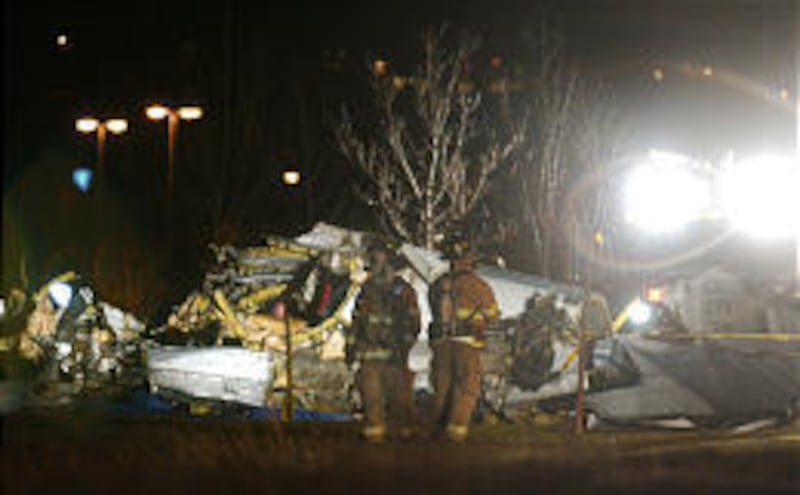LITTLETON, Colo. — The model of aircraft that plummeted nose first into a parking lot south of Denver on Friday night killing two pilots has been involved in scores of fatal accidents in its history.
The Mitsubishi MU-2, widely considered a cheap and fast cargo plane, have been involved in 180 accidents in the past 36 years, with more than 200 fatalities, according to the National Transportation Safety Board.
The plane that crashed Friday just after taking off from Centennial Airport had to make an emergency landing 15 years ago after a propeller fell off one of its engines near Erie, Pa., federal aviation records show.
Some pilots familiar with the MU-2 say it is difficult to maneuver, particularly at low altitudes and speeds. One longtime pilot questions whether the model should continue to be in service.
A review of the backgrounds of the pilots killed in Friday's crash shows neither was certified to fly that model aircraft, according to available federal aviation records.
Pilot Paul Krysiak, 28, of Aurora, Colo., and trainee James Presba, 25, of Lone Tree, Colo., died in the crash.
Krysiak, who had more than 3,000 flight hours, had been a pilot for Flight Line Inc., located at Front Range Airport in Watkins, Colo., for a year, Flight Line President Anthony Mulei said Saturday. "Paul was a very good person and an excellent pilot," he said.
Federal Aviation Administration pilot records show Krysiak held an airline transport pilot's certificate that was issued in January. The only "type rating," or aircraft-type certification, that Krysiak had on his FAA record was for the BE-300, which aviation officials said refers to the Beechcraft King Air 300.
Presba was a pilot and joined the flight as part of his training to become a Flight Line employee, Mulei said. The freight company employs 20 pilots, he said. "He was not in command or ready to fly the plane," Mulei said.
Presba held a commercial pilot's certificate, issued in April 2003. He had no type ratings on his FAA airmen's record. Presba also had flight instructor and ground instructor certificates.
Krysiak flew the plane five times a week, transporting freight to Salt Lake City, his destination Friday night, Mulei said. He was scheduled to make a return trip at 11:30 p.m. Friday night, Mulei said.
The plane was carrying checks and parts for agricultural equipment, Mulei said.
Within a minute after takeoff, air traffic controllers received a distress call from Krysiak, who said he was having engine problems, said Aaron Sauer, air safety investigator for the NTSB. Krysiak did not specify what troubles he was having.
The pilot was cleared to return to the airport, Lt. Tim Moore, spokesman for the Douglas County Sheriff's Office, said. But when he received an instruction from the control tower to bank right, his plane banked left, Sauer said, adding that it is unclear why he did so. The pilot could have been steering the plane to the left for tactical reasons or because he didn't have control of the plane, Moore said.
Pilot Mike Postel said he was landing at Centennial Airport as the MU-2 took off. "He was flying unusually low for this area," Postel said.
Postel said the weather was "beautiful" at the time of the crash. He said he heard the MU-2's pilot tell the air-traffic controller that he needed to shut down one of his engines.
The air-traffic controller asked him whether he needed assistance when he landed. "Go ahead and run," the pilot said, accepting the request for assistance.
"I was paying attention to what I was doing, and then when I looked back, I didn't see him anymore," Postel said.
According to another witness, the twin-engine MU-2 fell nose first into a parking lot short of the suburban airport.
Cheryl Poage, a spokeswoman for the Parker Fire Department, said six planes have crashed in recent years in the area south of Centennial, one of the busiest general aviation airports in the country.
FAA records show Flight Line has had a few minor crashes over the years and a fatal crash in February 2000 involving a Mitsubishi plane similar to the one that crashed Friday night.
Longtime pilot Robert Cadwalader, who has spent many hours analyzing aircraft accident statistics, said he believes the NTSB should re-evaluate whether the MU-2 is safe enough to remain in the air. He said the MU-2 was used more widely in the past for passenger travel, but insurance costs grew and it is now generally used only for cargo.
"They won't insure them for charter, or they'll make it so incredibly expensive you can't afford it," Cadwalader said.
But Arlie Aeschliman, owner of Pheasant Flying Services in Holly, Colo., said a lot of pilots love the MU-2. Aeschliman, a pilot and mechanic, said they can be tricky when learning to fly them, but called them "really beautiful flying machines."
Efforts to reach representatives of Mitsubishi were unsuccessful on Saturday.

